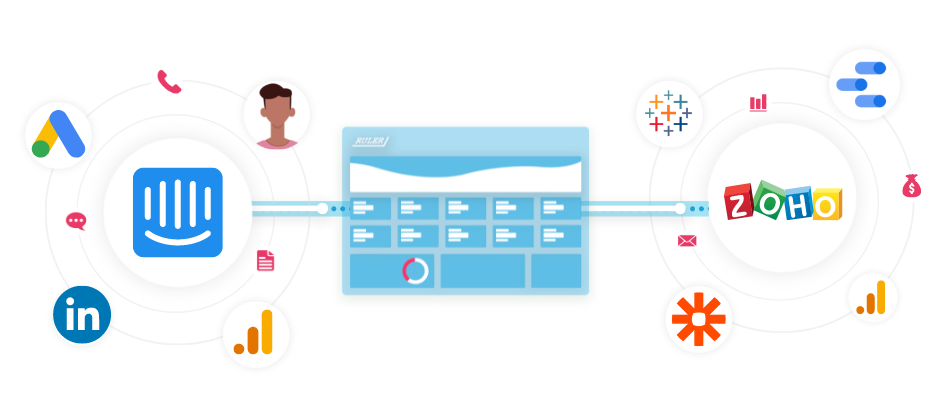
Introduction: The Power of Unified Customer Data
In today’s fast-paced business environment, understanding your customers is no longer a luxury – it’s an absolute necessity. You need to know who they are, what they need, and how to best serve them. This is where the magic of Customer Relationship Management (CRM) systems comes into play. And when you combine the power of a CRM with the real-time communication capabilities of a platform like Intercom, you unlock a whole new level of customer engagement and business efficiency.
This article will delve deep into the world of CRM integration with Intercom. We’ll explore the ‘why’ and the ‘how,’ providing you with the knowledge and practical steps you need to seamlessly integrate these two powerful tools. Whether you’re a seasoned professional or just starting out, this guide is designed to help you harness the full potential of this integration and transform the way you interact with your customers.
Understanding the Core Concepts: CRM and Intercom
What is a CRM?
At its heart, a CRM is a system designed to manage and analyze customer interactions and data throughout the customer lifecycle. It’s a central hub for all your customer-related information, including contact details, purchase history, communication logs, and more. Think of it as the brain of your customer relationships. Key functions of a CRM include:
- Contact Management: Storing and organizing customer data.
- Sales Automation: Streamlining sales processes.
- Marketing Automation: Automating marketing campaigns.
- Customer Service: Managing customer support interactions.
- Reporting and Analytics: Providing insights into customer behavior.
Popular CRM platforms include Salesforce, HubSpot, Zoho CRM, and many more. Each offers a slightly different set of features and caters to different business needs and budgets.
What is Intercom?
Intercom is a customer messaging platform that allows businesses to communicate with their customers in real-time, across multiple channels. It’s more than just a live chat tool; it’s a comprehensive platform for customer engagement, support, and sales. Key features of Intercom include:
- Live Chat: Providing instant support and assistance.
- Product Tours: Guiding users through your product.
- Targeted Messages: Sending personalized messages to specific customer segments.
- Help Desk: Offering self-service support through a knowledge base.
- Chatbots: Automating routine tasks and providing instant answers.
Intercom excels at fostering direct, personalized communication, making it an invaluable tool for building strong customer relationships.
The Benefits of CRM Integration with Intercom
Integrating your CRM with Intercom is a game-changer. It’s like giving your customer-facing teams superpowers. The benefits are numerous and far-reaching, impacting everything from sales and marketing to customer support and product development.
Enhanced Customer Understanding
By combining data from your CRM and Intercom, you gain a 360-degree view of your customers. You can see their interactions with your website, their past purchases, their support tickets, and their real-time conversations. This holistic perspective allows you to understand their needs, preferences, and pain points more effectively.
Personalized Customer Experiences
With a deeper understanding of your customers, you can deliver highly personalized experiences. Imagine being able to greet a returning customer by name, offer them tailored product recommendations based on their past purchases, or proactively address any issues they might be facing. Personalization drives engagement, increases customer satisfaction, and fosters loyalty.
Improved Sales Efficiency
Sales teams can leverage the integration to prioritize leads, identify high-potential prospects, and personalize their outreach efforts. They can access customer data directly within Intercom, eliminating the need to switch between multiple systems. This streamlines the sales process, saves time, and increases the likelihood of closing deals.
Streamlined Customer Support
Customer support teams can access a wealth of information about each customer within the Intercom interface. This includes their purchase history, support tickets, and past conversations. Armed with this context, support agents can resolve issues more quickly and efficiently, leading to happier customers and reduced support costs.
Data-Driven Decision Making
The integration provides a richer data set for analysis. You can track key metrics such as customer engagement, conversion rates, and customer satisfaction. This data can be used to make informed decisions about your sales, marketing, and customer support strategies, leading to continuous improvement and better business outcomes.
Step-by-Step Guide to Integrating Your CRM with Intercom
The specific steps for integrating your CRM with Intercom will vary depending on the CRM platform you use. However, the general process remains consistent. Here’s a step-by-step guide to help you get started:
Step 1: Choose Your Integration Method
There are several ways to integrate your CRM with Intercom:
- Native Integrations: Many CRM platforms offer native integrations with Intercom. These integrations are often the easiest to set up and provide the most seamless experience. Check your CRM’s app marketplace or integration settings to see if a native integration is available.
- Third-Party Integrations: If a native integration isn’t available, you can use a third-party integration platform like Zapier, Make (formerly Integromat), or PieSync. These platforms allow you to connect various apps and automate workflows.
- Custom Integrations: For more advanced customization, you can develop a custom integration using Intercom’s API and your CRM’s API. This option requires technical expertise but offers the greatest flexibility.
Choose the method that best suits your technical skills and business needs.
Step 2: Prepare Your CRM and Intercom Accounts
Before you begin the integration, make sure you have the following:
- Active CRM Account: Ensure you have an active subscription to your chosen CRM platform.
- Active Intercom Account: Ensure you have an active subscription to Intercom.
- API Keys: You may need to generate API keys in both your CRM and Intercom accounts. These keys are used to authenticate the connection between the two systems.
- User Permissions: Make sure the user account you’ll be using for the integration has the necessary permissions to access and modify data in both systems.
Step 3: Set Up the Integration
The setup process will vary depending on the integration method you choose. Here’s a general overview:
- Native Integrations: Follow the instructions provided by your CRM platform. This typically involves connecting your Intercom account to your CRM account and mapping data fields.
- Third-Party Integrations: Use the integration platform’s interface to connect your CRM and Intercom accounts. You’ll need to authenticate the connection using your API keys. Then, you’ll map data fields between the two systems, specifying which data should be synchronized.
- Custom Integrations: This involves writing code using Intercom’s and your CRM’s APIs. You’ll need to define the data synchronization logic and handle error conditions.
Step 4: Map Data Fields
Data mapping is a crucial step in the integration process. It involves specifying which data fields in your CRM should be synchronized with which data fields in Intercom. For example, you might map the ‘Email’ field in your CRM to the ‘Email’ field in Intercom. Common fields to map include:
- Contact Information: Name, email address, phone number, company name.
- Account Information: Account name, industry, revenue.
- Deal Information: Deal stage, deal value, expected close date.
- Custom Fields: Any custom fields you’ve created in your CRM.
Carefully consider which fields are most important for your business and map them accordingly. The more data you synchronize, the more powerful the integration will be.
Step 5: Test the Integration
After setting up the integration and mapping the data fields, it’s crucial to test it thoroughly. Create a test contact or lead in your CRM and see if the data is synchronized to Intercom. Then, send a test message through Intercom and check if the conversation history is recorded in your CRM. Make sure that the data flows correctly in both directions.
Step 6: Monitor and Optimize
Once the integration is live, monitor its performance regularly. Check for any errors or data synchronization issues. Pay attention to how your sales, marketing, and customer support teams are using the integration and identify any areas for improvement. You might need to adjust your data mapping or workflows over time to optimize the integration for your specific needs.
Best Practices for CRM Integration with Intercom
To maximize the benefits of your CRM integration with Intercom, follow these best practices:
Define Clear Goals
Before you begin the integration, define your goals and objectives. What do you hope to achieve by integrating your CRM and Intercom? Do you want to improve sales efficiency, enhance customer support, or personalize marketing campaigns? Having clear goals will help you prioritize your efforts and measure your success.
Choose the Right CRM and Intercom Plans
Make sure you’re using the right plans for your business. Consider your team size, your customer volume, and the features you need. Both CRM platforms and Intercom offer various plans with different features and pricing. Choose the plans that best fit your needs and budget.
Clean and Organize Your Data
Ensure that your CRM data is clean, accurate, and up-to-date. Inaccurate or incomplete data will lead to poor customer experiences and wasted effort. Regularly review and update your data to maintain its quality. Consider implementing data validation rules to prevent errors.
Prioritize Data Security
Protect your customer data by implementing strong security measures. Use secure passwords, enable two-factor authentication, and regularly review your security settings. Comply with all relevant data privacy regulations, such as GDPR and CCPA.
Train Your Team
Provide adequate training to your sales, marketing, and customer support teams on how to use the integrated system. Explain the benefits of the integration, demonstrate how to access and use the data, and provide guidance on best practices. Ongoing training and support are essential for ensuring that your team members can effectively leverage the integration.
Automate Workflows
Use the integration to automate repetitive tasks and streamline your workflows. For example, you can automatically create new leads in your CRM when a customer initiates a conversation in Intercom. Or, you can automatically update a customer’s status in your CRM when they complete a purchase. Automation saves time, reduces errors, and improves efficiency.
Personalize Your Communication
Leverage the integrated data to personalize your communication with customers. Use their names, their purchase history, and their past conversations to tailor your messages and offers. Personalization makes customers feel valued and increases the likelihood of engagement.
Monitor and Analyze Your Results
Track key metrics to measure the success of your integration. Monitor customer engagement, conversion rates, customer satisfaction, and other relevant metrics. Analyze the data to identify areas for improvement and make data-driven decisions. Continuously evaluate and optimize your integration to maximize its impact.
Advanced Tips and Tricks
Once you’ve mastered the basics of CRM integration with Intercom, you can explore some advanced techniques to further enhance your customer relationships:
Leverage Intercom’s Custom Attributes
Intercom allows you to create custom attributes to store additional information about your customers. You can use these attributes to segment your audience, personalize your messages, and trigger automated workflows. For example, you could create a custom attribute to track a customer’s product usage or their customer lifetime value.
Use Intercom’s Bots to Qualify Leads
Intercom’s bots can be used to qualify leads and gather information about their needs and interests. You can integrate this information with your CRM to automatically create new leads or update existing lead records. This can help you prioritize your sales efforts and focus on the most promising prospects.
Integrate with Other Tools
Consider integrating your CRM and Intercom with other tools in your tech stack. This can further streamline your workflows and provide a more holistic view of your customers. For example, you could integrate with an email marketing platform to automatically add new leads to your email lists or integrate with a project management tool to track customer projects.
Create Automated Workflows Based on Customer Behavior
Use the integrated data to create automated workflows that are triggered by customer behavior. For example, you could send a follow-up message to a customer who abandons their shopping cart or trigger a support ticket when a customer experiences a product issue. These automated workflows can help you proactively address customer needs and improve customer satisfaction.
Utilize A/B Testing for Personalized Messaging
Experiment with A/B testing to refine your messaging and optimize your customer interactions. Test different subject lines, message content, and calls to action to see which variations perform best. Use the results to personalize your messaging and improve your conversion rates.
Troubleshooting Common Integration Issues
Even with careful planning, you may encounter some issues during the CRM integration process. Here are some common problems and how to resolve them:
Data Synchronization Errors
Problem: Data is not synchronizing correctly between your CRM and Intercom. This could be due to incorrect field mapping, API errors, or data format issues.
Solution:
- Double-check your field mapping to ensure that the data fields are correctly mapped between the two systems.
- Review the error logs in your integration platform or CRM to identify any API errors.
- Verify that the data formats are compatible between the two systems.
- Contact the support team for your CRM or integration platform for assistance.
Missing Data
Problem: Data is missing from your CRM or Intercom after the integration. This could be due to incorrect data mapping, filtering issues, or data loss during the synchronization process.
Solution:
- Review your data mapping to ensure that all relevant fields are being synchronized.
- Check for any filters that might be preventing data from being synchronized.
- Review the data synchronization logs to identify any data loss.
- Contact the support team for your CRM or integration platform for assistance.
Performance Issues
Problem: The integration is slowing down your systems or causing performance issues. This could be due to large data volumes, API rate limits, or inefficient data synchronization processes.
Solution:
- Optimize your data synchronization processes to minimize the amount of data being transferred.
- Implement data filtering to synchronize only the data that is needed.
- Monitor your API usage and identify any rate limits.
- Contact the support team for your CRM or integration platform for assistance.
Security Concerns
Problem: You are concerned about the security of your customer data after the integration. This could be due to unauthorized access, data breaches, or compliance issues.
Solution:
- Implement strong security measures, such as secure passwords, two-factor authentication, and data encryption.
- Review your security settings in your CRM and Intercom accounts.
- Comply with all relevant data privacy regulations, such as GDPR and CCPA.
- Regularly audit your security practices and make any necessary updates.
Conclusion: Embracing the Future of Customer Relationships
CRM integration with Intercom is more than just a technical setup; it’s a strategic investment in your customer relationships. By unifying your customer data and communication channels, you can deliver personalized experiences, improve sales efficiency, streamline customer support, and make data-driven decisions. The benefits are clear, and the potential for growth is immense.
Take the time to explore the possibilities of this integration. Choose the right integration method, map your data fields carefully, and train your team to leverage the power of the combined system. Continuously monitor, analyze, and optimize your efforts to ensure that you’re getting the most out of your investment.
In the ever-evolving landscape of customer engagement, those who embrace innovation and prioritize customer-centricity will thrive. CRM integration with Intercom is a powerful tool that can help you build stronger customer relationships, drive business growth, and stay ahead of the competition. So, take the first step today and unlock the full potential of your customer relationships.


